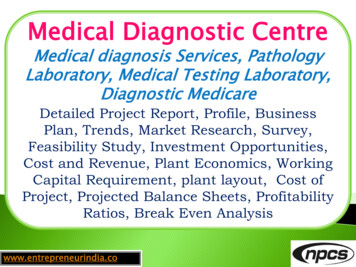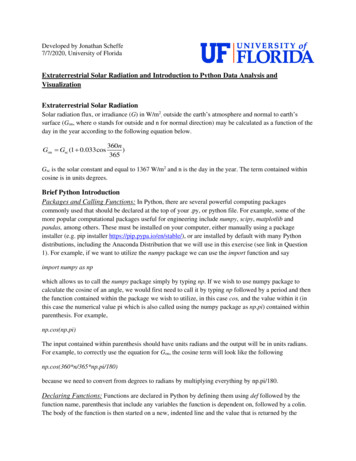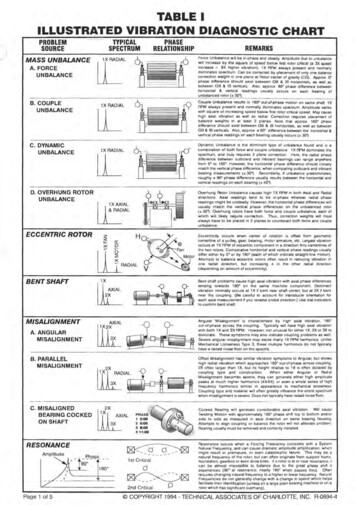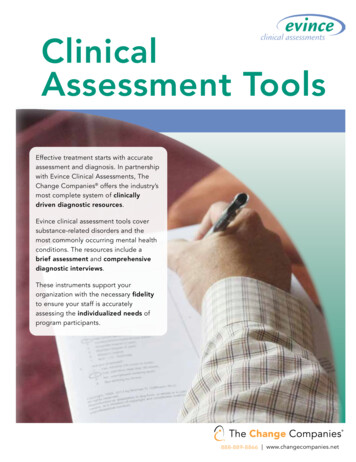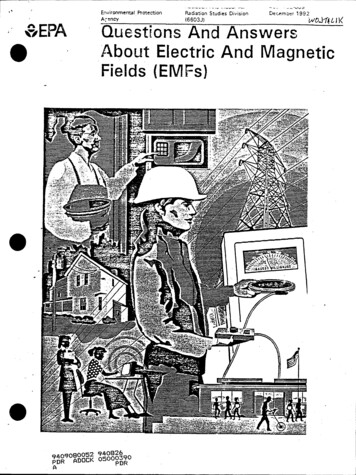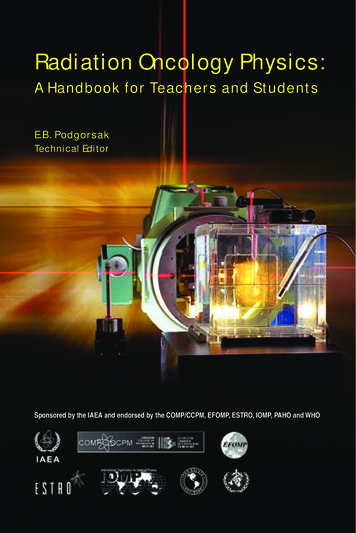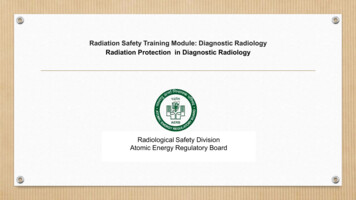
Transcription
Radiation Safety Training Module: Diagnostic RadiologyRadiation Protection in Diagnostic RadiologyRadiological Safety DivisionAtomic Energy Regulatory Board
Content Mission of AERBICRP-Principle for Radiological protection(Practice)Types of Radiation Generating Equipment: (RGE)Typical patient dosesRadiation Protection for occupational workersRadiation Protection for patientConclusions
Mission of the AERBThe Mission of the AERB is to ensure the use of ionising radiation andnuclear energy in India does not cause undue risk to the health of peopleand the environment.To protect people (workers, public and patients) from harmful effects ofionising radiation without unduly limiting the use of techniques that maycause radiation exposure
INTERNATIONAL COMMISSION ON RADIOLOGICALPROTECTION(ICRP) RADIATION SAFETY PROGRAMME SHOULDBE DESIGNED TO :PREVENT DETRIMENTAL TISSUE REACTIONS (DETERMINISTIC EFFECTS)LIMIT or MINIMIZE THE PROBABILISTIC EFFECTS TO ACCEPETABLE LEVELS
ICRP-Principle for RADIOLOGICAL PROTECTION JUSTIFICATION OPTIMISATION (ALARA ) DOSE LIMITATIONSNever exceed Dose Limits
JUSTIFICATION The most common type of ionizing radiation used in medicine all over theworld are X-rays since its discovery. There are obvious benefits from medical uses of X-rays , however there arewell established health risks from radiation if improperly applied. Henceevery medical procedure involving radiation needs to be justified. It is fact that diagnostic x-ray examinations contribute the largest fraction topopulation dose from man made radiation sources.
OPTIMIZATION All living things are exposed to ionising radiation from the natural (calledbackground radiation) and man made radiation sources Ionising radiation may cause biological changes in the exposed personhence the doses to the occupational workers shall be kept as low asreasonably achievable and doses to patients shall be optimized. Suitable control measures shall be employed to minimiseradiation exposure so that maximum benefits are derived withminimum radiological risk.
DOSE LIMITSPart of the bodyOccupational ExposurePublic ExposureWhole body(Effective dose)20 mSv/year averaged over5 consecutive years;30 mSv in any single year150 mSv in a year1 mSv/yLens of eyes15 mSv/y(Equivalent dose)Skin500 mSv in a year50 mSv/y(Equivalent dose)Extremities500 mSv in a year(Hands and Feet)Equivalent doseFor pregnant radiation workers, after declaration of pregnancy 1 mSv on theembryo/fetus should not exceed
Types of Radiation Generating Equipment:(RGE) Computed TomographyInterventional RadiologyRadiography (Fixed/Mobile)C-Arm/ O-ArmMammographyBMDDental (Intraoral/OPG/CBCT)Note: MRI and Sonography (Ultrasound) or non- ionising RGE do not come under purview of AERBregulations23 May 20179
Computed TomographyInterventional RadiologyRadiography /FluoroscopyMammographyBMDC-ArmDental OPG/CBCTDental-IOPA
Average Effective Dose (mSv) for diagnosticradiology proceduresExamDose (mSv)Dental x-rays0.01Mammogram0.04Chest x-ray0.10Abdomen x-ray0.7Lumbar spine1.5Chest CT7.0Abdominal CT8.0Natural Background 3.1 mSv/ yearcf: Mettler et al. Radiology 2008, 248(1):254-263
Computed Tomography EquipmentPatient Effective Dose: 2-20 mSv
Interventional Radiology(Angiography & Angioplasty procedures)Patient Effective Dose: 1to100 mSv
General RadiographyPatient Effective Dose :0.1 – 1 mSv
Mammography UnitPatient Effective Dose : 0.4 mSv15/9
Dental Radiography (IOPA)Patient Effective Dose : 0.005 –0.01 mSv
Dual Emission X-ray Absorptiometry (DEXA)/BMDPatient Effective Dose : 0.001mSv17/98
RadiationSafetyOperationalSafetyTime Distance ShieldingProperWorkPracticeBuilt-in safety(Design In this presentation we have considered only operational safety componentsBuilt is safety requirements are elaborated in separate presentation23-May-1718
Basic Factors for Radiation Protection Time Distance ShieldingI1 d12 I2 d2 2 (INVERSE SQUARE LAW))
To reduce the Radiation dose to the individual- Reduce the time spent near the X-ray source (reducefluoroscopy procedure time) Increase the distance from the X-ray source Interpose a shielding material between X-ray source andOperator- (Use of radiation protection accessories)23-May-1720
Operational SafetyComponents of operational safety Handling of equipment by Qualified persons Use of protective accessories Mobile Protective Barrier, Lead Apron, Organ shield etc. Usage of Personnel monitoring devices (TLD) Preventive maintenance and periodic QA of equipment Updating with the current regulatory requirements21
Protection of Staff/OperatorUse protective devices! Advisable skirt type lead apron to distributeweight. use of lead apron (0.25 mm lead equivalent),radiation dose would be reduced by more than 90 % Use ceiling suspended screens, lateral shields andtable curtains- must for interventional radiologyprocedures.0.25 mm Lead Eqv. glass eyewearwith side protection
Ways to minimize radiation exposure Always collimate to the area of interest, the larger the amount of tissue the beam is allowed to irradiatethe more scatter radiation is produced. Avoid holding of infirm patient by staff, provide protective apron to the attendant while holding suchpatients. Always operate the equipment from behind the protective barrier or using lead equivalent apron. During fluoroscopy exams always make sure that built in safety devices such as flaps /ceilingsuspended glass/ couch hanging flaps as applicable are available and use it on routine basis. During use of mobile x-ray equipment stand at least 6 feet away from the patient and wear lead apron. During c-arm procedures standing on the side of the image intensifier is safest because there is morescatter produced at the entrance surface side of the patient. During use of Portable X-ray equipment, ensure that X-ray tube is immobilized on the stand and filmcassette shall not be held in hand by any person.
In Fluoroscopy hepatient. Highest scatter radiation levelsareoftenwheretheoperatorstands. Radiation levels are highestbeneath the table (when X-ray tube isbelow the table) hence couch hanginglead equivalent rubber flaps shall bealways used . In general, an operator positioned 3 feet from the X-raybeam entrance area will receive 0.1% of the patient’sEntrance Skin Exposure.Staff members positioned further away from patient receivemuch less exposure due to inverse square law effects.
proper storage of radiation protection devices-Lead apron23-May-1725
Personal Monitoring Badge (TLD)(Refer guidelines for proper use of TLD badges)Wear TLD badge inside the Lead apron at chestlevel –RadiographyTLDFor R/F or in Cath Lab One inside the apron at chest level Additional wrist badge for proceduresrequiring hands close to primary beamAfter work, store TLD badges in radiation freeareaControl TLD Card should be kept away fromradiation areaTLD belowapronTLD aboveapron
Radiation Protection Accessories Mobile Protective Barrier (MPB)- 1.5 mm Lead EqvLead Aprons - 0.25 mm Lead EqvThyroid Shield -0.25 mm Lead EqvGonads Shield- 0.25 mm Lead EqvEye Wear (Shield)- 0.25 mm Lead EqvRubber hanging Flaps (In IR )-0.5 mm Lead EqvHand Gloves -0.25 mm Lead EqvLead Glass window- 1.5 mm Lead EqvDoor (Lead Lined)-1.7 mm Lead Eqv23-May-1727
Radiation Safety Carry out Quality Assurance testing of each & every X-ray equipment once inTWO YEARS. Improves imaging standard Increase the Life of the X-ray tube/ equipment by avoiding retakes Useful in reduction of unnecessary patient’s Dose & hence dose to the staff A good knowledge of equipment specification and characteristics is essential foran effective optimization of radiation protectionOccupational doses can be reduced by reducing patient dose. The proper useof equipment (including shielding devices) is essential.
Patient dose management Quality control protocols –– Justify the procedure– Ask for records of previous diagnostic procedures– Plan the procedure (right patient, right contrast, purpose of scan/investigation)– Know well about your equipment settings– Ensure only qualified and trained operator should operate the equipment– Inform patient about his/her procedure– Handover procedure records (CD/disc and reports) including radiation dose records topatient.– Ensure that daily and periodic QA are performed and equipment performance is satisfactory.
Patient ProtectionRadiation safety during x-ray examination of patient is ensured by: Limiting the total “beam–on” time Avoiding oblique lateral projections Prior to exposure,collimate the x-ray beam to the area of interest , AVOID post exposurecropping of the image Selecting low dose rate protocol Use of correct exposure protocols for patient examinations including paediatric protocols Monitoring of DLP in CT and DAP values for IR procedures and record- keeping of patient’s doses for CT and IR procedures.31
REDUCING UNNECESSARY DOSE TO PATIENTSScreen film imagingCourtesy: imagegently.Over exposures are obviousBest quality image is not normally necessary forrequired diagnosis.Exposure field should be always collimated to thearea of interestBucky/grid should be used judiciouslyREMEMBER Small conscious steps go a longway in optimizing doses to patients.Latest equipment are provided with additional Cufilters. Very good in reduction of patient doseOver exposures remain unnoticedOn pregnant patients, always useadditional shields, if it is felt that theabdomen is likely to get unnecessarilyexposed.Use Digital imaging correctly to reap its benefits !!
Radiation protection of paediatric patientsWhy are children receiving higher doses? Using unsuitable Automatic Exposure systems; in imported equipment, which are not customized toIndian demography before use. Following adult exposure protocols for children Expecting best quality images, even if there is no additional gain in terms of diagnosis Not using dose-minimising features that machine provides. Radiographs taken by unqualified personnel, who do not fully appreciate the implication of theiractions. Not considering alternate means of diagnosis (MRI, USG etc). Not asking for previous x-ray records, for the same ailment.
Radiation protection of paediatric patientsKeep in mind for Child examinations . Grid should not normally be used Use equipment with high power i.e. higher mAand shortest time Ensure that for AEC systems, protocols arecustomized to Indian child. Use thyroid, gonad shields & immobilizationdevicesAVOID “BABYGRAMS”!!!EXPOSE ONLY AREA OFINTEREST
Additional considerations forComputed Tomography andInterventional Radiology
If patient doses are higher than the expected level, but not high enoughto produce obvious signs of radiation injury, the problem may goundetected and unreported, putting patients at increased risk for longterm radiation effects. Every facility performing CT imaging should periodically review its CTprotocols and be aware of the dose indices ( such as CTDI, DLP )
Major reasons in increasing dose1. Seeking Image quality higher than necessary2. Unjustified examinations,3. Not using the features that the machine provides for dosereduction
Pediatric CT 30% to 40% of CT exams can be managed with alternate modalities(eg USG,MRI etc.). Overuse of multiphase exams in pediatric practice. Paediatric exams typically use kVp values that are too high Same exposure factors used for children as for adult Same exposure factors for pelvic (high contrast region) as for abdomen(low contrast region)
Image gently “Child size” the amount of radiationused Scan only when necessary Scan only the indicated region Scan once; multiphase scanning isusually not necessary for children
Automatic Exposure Control Dose increases if one does not select factors properly e.g. Noise indexor image quality parameter If one selects High noise index- poor image quality, low dose Low noise index- good quality, high dose Example: Kidney for stones: unlikely to be missed even in low dosescan, but for appendicitis- higher dose scan is needed Heavy patient- upper value may reach
InterventionalRadiologyCTRadiography41
Interventional Radiology -History Minimally invasive fluoroscopically guided proceduresDr. Charles Dotter, MD – Interventional radiologistNobel Prize in Medicine in 1978.Invention of Angioplasty using catheter delivered stentIn some cases this is an alternate option to open surgery42
Lengthy and complex procedures Operating staff very close to the patient Prolonged exposure time No appropriate use of shielding accessories 43
Many interventionists are not aware of the potential for injury fromprocedures, their occurrence or the simple methods for decreasing theirincidence utilizing dose control strategies. Many patients are not being counseled on the radiation risks, nor followed upfor the onset of injury, when radiation doses from difficult procedures maylead to injury.44
Doses of the orderof 1Gy to 22Gy45
Patient Radiation Dose Patient Dose Typical entrance exposure rates for fluoroscopic imaging areAbout 1 to 2 R/min for thin (10-cm) body parts, so skin injury thresholdcan be reached in approx. 100-200 min3 to 5 R/min for the average patient, approx. 40-67 min8 to 10 R/min for the heavy patient, approx. 20-25 min The maximum entrance exposure rate for normal fluoroscopy to the patientis 10 R/min For specially activated fluoroscopy (audible alarm), the maximum exposurerate is 20 R/min46
C-Arm Fluoroscopy-Shielding With the C-arm oriented vertically, the x-ray tube should be located beneath the patientwith the II above In a lateral or oblique orientation, the x-ray tube should be positioned opposite the areawhere the operator and other personnel are working In other words, the operator and II should be located on the same side of the patient This orientation takes advantage of the patient as a protective shield47
Distance Rule of thumb (diagnostic energy range): At 1 m from a patient at 90 degrees to the incident beam, the radiation intensity is1/1000th the intensity of the beam incident at the patient More precisely: 0.1% - 0.15% (0.001 to 0.0015) of the intensity of the beam incidentupon the patient for a 400 cm2 area field area The NCRP recommends that personnel should stand at least 2 m from the x-ray tubeand the patient and behind a shielded barrier or out of the room, whenever possible48
Shielding49
Protective Devices – Quality Control All lead equivalent vinyl material (aprons, gloves, etc) should complywith relevant international standards. They should be tested atpurchase and regularly thereafter, at least every 2 years. Incorrect storage may lead to cracks in the shielding but thismay not be detectable by visual inspection alone A simple test is to examine the devices using fluoroscopy (atabout 60 kVp). The use of automatic dose rate or automaticbrightness controls should be avoided. This test will only detect flaws in the shielding. Faulty devicesshould be discarded immediately
CONCLUSIONS The majority of the radiation dose received by the operator (provided the primary beam is avoided) is due to scatteredradiation from the patient. Know your equipmentUse protective shields (lead apron, mounted shields/flaps, ceiling suspended screens as applicable)Avoid holding of patient without adequate protection.Keep hands out of the primary beamStand in the correct place: opposite the X ray tube rather than near the X ray tube.(knowledge of iso-dose curve)Always wear your personal radiation monitoring badge and use them in the right mannerMake sure that x ray equipment is properly functioning and periodically tested and maintainedAll actions to reduce patient dose will also reduce staff dose.Follow Time, Distance, Shielding golden rules
While drawing immense medical benefits form the application of X-rays,care need to be taken against the hazards associated with them. Use of appropriate protective accessories and equipment specificsafety features will ensure optimization of patient and staff dose. The prime responsibility for ensuring safety of X-ray installations restswith the user institution.
Questions:1. What is the mission of AERB?Ans: The Mission of the AERB is to ensure the use of ionising radiation and nuclear energy in India does not causeundue risk to the health of people and the environment2. What are the basic factors for radiation protection in Diagnostic radiology?Ans: Time, Distance & shielding3. What is the relation between distance & X-rays exposure?Ans: X-ray exposure follows inverse square law with distance-I1 d12 I2 d2 24. Where TLD control card should be stored?Ans: in radiation free area such as Admin room, reception room etc5.What are the different types of radiation protection accessories to be used duringthe diagnosis of patients?Ans: Lead apron, protection barrier, lead eye glass, gonad shield, hand gloves,thyroid shield etc.
6. What are the recommendatory lead equivalence for Radiation protective barrier, viewing glass window, lead apron and door of the Xray installation room?Ans: Protective barrier-1.5 mm of Lead Eqv, Viewing glass window-1.5 mm of Lead Eqv,Lead apron- 0.25 mm of Lead Eqv and door-1.7 mm of Lead Eqv7. Where to store the TLD badge after the routine work.Ans: In radiation free area (Outside the X-ray installation room)8. How to ensure the safe work practice during diagnosis of patients?Ans:Implementation of following things can ensure the patient safety:Limiting the total “beam–on” timeAvoiding oblique lateral projectionsCollimation to limited beam sizeSelecting low dose rate protocolUse of Exposure protocols for patient examinations including paediatricuse of DLP in CT and DAP values for IR procedures andRecord keeping of patient’s doses for CT and IR procedures.protocols
9. Why QA tests of the X ray equipment should be carried out periodically?Ans: Very useful to maintain quality of equipmentImproves imaging standardIncrease the Life of the X-ray tube/ equipmentUseful in reduction of unnecessary patient’s Dose & hence dose to thestaff
References and sources for additional information: The Essential Physics of Medical Imaging (J. T. Bushberg, J.A. Seibert, E.M.Leidholdt, J M Boone) The Physics of Radiology (H.E. Johns, J.R. Cunnighnam)Introduction to Health Physics (H. Cember)Radiation Detection and Measurement (G. Knoll)IAEA Presentations on Diagnostic Radiology
List of presentations in the training ModuleBasics of Diagnostic X-ray EquipmentBiological effects of RadiationsMedical X-ray imaging techniquesPlanning of Diagnostic X-ray facilitiesQuality Assurance of X-ray equipmentQuality Assurance of Computed Tomography equipmentRadiation Protection in Diagnostic Radiology PracticeCauses, prevention and investigation of excessive exposures indiagnostic radiologyRegulatory Requirements for Diagnostic Radiology Practice
Interventional Radiology -History Minimally invasive fluoroscopically guided procedures Dr. Charles Dotter, MD –Interventional radiologist Nobel Prize in Medicine in 1978. Invention of Angioplast
